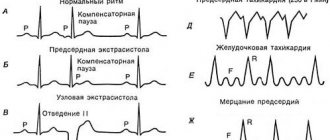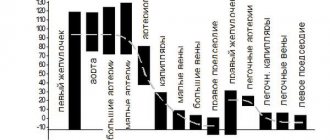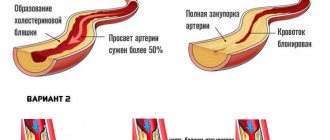Hello, dear reader of our site! Today we will talk about the possibility of serving in the army with arterial hypertension (sometimes called hypertension). Indeed, hypertension can be treated , but, fortunately, not in all cases. We will tell you which ones below.
Not every conscript who has arterial hypertension has the right to a deferment from conscription into the army.
Can people with arterial hypertension be recruited into the army?
Arterial hypertension is detected by high blood pressure in a chronic form. In this case, pressure readings do not drop from 140-149/90-99 mmHg. Art.
Hypertensive crises are also possible, in which blood pressure rises to 200/110 mmHg. Art.
The question of the possibility of serving in the army is decided after passing a medical commission. The conscript is examined, undergoes tests, on the basis of which narrow (and not only) specialists make their conclusions. They are decisive in the question of whether the patient will be released from the army. In the process of a comprehensive examination, other diseases are often discovered that develop against the background of high blood pressure or, conversely, serious pathologies, a symptom of which is high blood pressure.
Hypertension is detected by constant headaches, heart problems, hyperhidrosis, and redness of the skin. Patients have constant fear and anxiety for their lives, memory is deteriorated, and their emotional and mental state is unstable. Hypertensive patients are constantly tense and unfocused.
The presence of the described clinical picture is a serious reason for a conscript with arterial hypertension to be assigned category B (limitedly fit for military service). A person with a disorder of the cardiovascular system cannot perform physical exercises or adapt to the conditions of the army without harm to health. Intense stress, both physical and emotional, can cause a heart attack or stroke. If diagnosed with stage 1 hypertension, risk 1 conscript can receive a white ticket if blood pressure readings are constantly elevated and this fact is confirmed by medical documents.
A history of periodic attacks of increased blood pressure cannot serve as a basis for avoiding the army.
What is considered hypertension?
Hypertension is a chronic disease, the main manifestation of which is an increase in blood pressure on a regular basis. The disease can be either an independent disease or a concomitant one. For example, constantly elevated blood pressure is observed in patients with pyelonephritis.
It is worth understanding that making an independent diagnosis in this case is completely useless, as is simply voicing the symptoms of the disease at the draft medical examination.
Hypertension is one of the diseases with which conscripts try to avoid military service, so the medical council, as a rule, takes into account only indisputable data about the disease, which is quite difficult to confirm.
Read more about how doctors pass the medical examination at the military registration and enlistment office on our website.
Mild arterial hypertension and the army
The diagnosis of mild arterial hypertension is made when blood pressure rises at certain points during 24-hour blood pressure monitoring (ABPM). It is also possible to normalize blood pressure without interventions (during sleep, during rest), but it is short-lived and occurs slowly. With hypertension, the pressure should be high on average.
If a conscript is diagnosed with mild hypertension, he is assigned fitness category B4, which means that the patient has been diagnosed with a disease that does not prevent military service. If pressure increases periodically during service conditions, the serviceman has the right to request a re-examination of his fitness category.
How to get exemption?
Doctors who conduct examinations should only describe the state of health, but not make diagnoses. Therefore, to obtain an exemption from military service, you need to go to the military registration and enlistment office with the appropriate documents.
Sometimes, even if all the certificates from doctors are collected, additional examination in a hospital may be required.
To obtain exemption from the army in case of GB, you need to perform a number of actions.
- You need to visit a therapist several times, who will measure your blood pressure and record high readings on the card.
- Treatment of the condition must be carried out in a hospital, therefore an extract from the hospital is also attached to the case.
- You need to undergo an examination twice, during which 24-hour blood pressure monitoring is carried out.
- Consultation with specialists will help identify related health problems.
The diagnosis of hypertension is made only after several months of registration and treatment. If the draft commission doubts the authenticity of documents and seals, a repeat examination may be carried out.
To obtain a military ID with a category B mark, you must provide all medical documents. If they are missing, then a decision will be made to assign group A or B. If the young man does not agree with the decision, he can appeal the commission’s decision.
Category G may be prescribed, which allows you to receive exemption from the army for six months. In this case, the man is sent to a hospital for treatment and examination. If after 6 months the illness is confirmed, then a final decision is made about complete unfitness for military service.
Under what pressure are people not recruited into the army in 2020?
The third degree of hypertension is considered dangerous when the systolic pressure is 180 mmHg. Art., and diastolic – 110 mm Hg. Art. The examination is carried out according to Article 43 (paragraph a), and a disability of group 1 is assigned.
If the diagnosis is confirmed, the young man receives non-conscription category D.
A conscript with blood pressure problems can also receive category G. In this case, he is given a deferment of 6 months to conduct additional studies in a hospital setting. Based on the results of repeated blood pressure monitoring and other studies, it is decided at the next conscription campaign whether the young man will serve in the Armed Forces or be released from the army.
How to get out of the army due to hypertension
Arterial hypertension has a complex etymology. So many were going to reject the army due to pressure? After all, the disease is associated with atmospheric pressure and leads to limited capacity, disability or death. Nervous overload during military service will lead to sudden death in this disease. Therefore, the question becomes logical: are hypertension and the army compatible?
To answer, you need to familiarize yourself with the law, which establishes a list of grounds for this.
How does a military medical commission decide on the fitness of a conscript?
The conscript must present to the medical commission an extract from the hospital with the results of a study conducted six months before conscription and the diagnosis established by the doctor.
The commission makes a decision on release from service on the basis of a medical examination (grade 2 and 3 hypertension), discharge from the hospital and medical history (regular applications to a cardiologist or therapist with complaints).
If necessary, the commission may order a repeat study in an inpatient setting.
Arterial hypertension is a serious disease with an increased risk of various complications. If you have the necessary documents and a competent approach to the problem, a conscript with such a diagnosis receives category B or D and is exempt from service in the Armed Forces.
Disease stages and fitness categories
The question of whether patients with high blood pressure are taken into the army is closely linked to how deep the disease has gone in its development. There are three stages of hypertension. The main criterion for differentiation is the absolute numbers of systolic and diastolic pressure. Visually it looks like this:
| Stage of hypertension | Systolic pressure (mm.av.st) | Diastolic pressure (mmHg) | Suitability category |
| Stage 1 | 140-159 | 90-99 | "B" or "G" |
| Stage 2 | 140-179 | 90-109 | "IN" |
| Stage 3 | 180 and above | 110 and above | "D" |
The table above is valid only for the second and third stages of hypertension development. When determining a conscript’s suitability for service when the disease is just developing, members of the medical commission do not always decide to establish category “B”. In case of doubt or episodic nature of the increase in pressure, category “G” can be determined. That is, a deferment from service is given for 6 months, less often for a year, so that the conscript has the opportunity to improve his health and receive treatment.
For members of the commission, the results of treatment and the opinions of the attending physicians are important, since they have the opportunity to observe the patient over time, over a long period of time. If the disease does not progress, category “G” can be changed to “B”, and then the conscript will go to the troops, but his service will not be associated with heavy physical activity.
Why are hypertensive patients treated with such concern in the army? This is due to the nature of the disease. First of all, hypertension affects the cardiovascular system. During the period of increased blood pressure, the heart begins to work under significant overload. Not having time to pump blood throughout the body, the heart muscle itself begins to experience fatigue and hypoxia - a lack of oxygen. The brain, which is very sensitive to the level of oxygen in the blood, is especially affected.
Under stress, adrenaline is released. The permeability of blood vessels increases, they become fragile. The most dangerous consequences of hypertension are heart attacks and strokes. A blood vessel supplying the heart or brain ruptures. Hematomas form, which compress the tissue and disrupt the blood supply to the heart muscle or part of the brain.
No army in the world can afford to keep a soldier who will become incapacitated by becoming over-excited as soon as he sees the enemy.
When establishing a fitness category, doctors proceed from the statistical probability of complications occurring in patients with hypertension in the next decade.
It equals:
- 1st degree – 15%;
- 2nd degree – 20%;
- 3rd degree – more than 30%.
Statistics show that if unfavorable conditions arise, 15% of soldiers with stage 1 hypertension will become incapacitated in the first 10 days. And if you conscript patients with stage 3 hypertension into the army, then in a month there will be no one left in the ranks.
The modern army does not strive for mass participation by replenishing its ranks with not entirely healthy people who are useless in combat conditions. Therefore, he wants to free himself as much as possible from ballast, which he will spend most of his time in hospitals rather than at landfills.
Medical examination
To avoid problems with the military registration and enlistment office, you need to start collecting medical documents in advance. It is better to regularly contact your local doctor with complaints of high blood pressure and poor health. You should not wait until you are of military age: confirmation of the diagnosis at the time of receipt of the summons will cause logical mistrust on the part of the commission.
A conscript to the army must receive a referral for examination in a hospital setting, as required by the rules.
Arterial hypertension is confirmed by:
- Blood pressure values measured over several days
- The results of the anamnesis,
- Ultrasound data of the heart and kidneys,
- ECG,
- EchoECG,
- According to the study of cerebral vessels,
- Blood and urine tests.
When assessing the general state of health, the presence of third-party chronic diseases, risk factors, and target organ damage is also taken into account.
Military service and neurocirculatory asthenia
In article 47, under paragraph “a”, the diagnosis of hypertensive type NCD is prescribed. The Army places this diagnosis in the service-restricted category. If persistent and significant vegetative-vascular disorders are observed, then conscripts are assigned categories “B” or “B”. In case of moderate symptoms, there may be no restrictions for service at the discretion of the medical commission.
Young men with confirmed neurocirculatory asthenia are most often recognized as temporarily unfit and referred for additional treatment.
NCD or vegetative-vascular dystonia has more than 150 symptoms, so doctors of various specializations are involved in its diagnosis and treatment - from ophthalmologists to nephrologists.
Upon re-examination, a conscript is considered fit for service if:
- He has severe vegetative-vascular disorders that cannot be treated,
- Lability of blood pressure is observed,
- There are untreatable diseases that are accompanied by disturbances in the functioning of the heart without the risk of developing a heart attack.
What are the symptoms of hypertension
Hypertension can manifest itself in different forms. When a person has high blood pressure, but from time to time it returns to normal unexpectedly without intervention, we can talk about transient hypertension (first stage). If an increase in blood pressure appears after a stressful condition or excessive physical activity, this form is called labile and requires treatment.
Constantly elevated blood pressure, at which fitness category B or D is assigned, requires a therapeutic course. Malignant hypertension is characterized by a strong increase in levels, in some cases leading to death.
Hypertensive crises are said to occur when blood pressure rises sharply.
Symptoms of the first degree of hypertension are mild and occur rarely, so the patient is often unaware of the presence of pathology. The main symptoms include:
- headache that worsens with physical or mental stress;
- tingling or aching pain in the chest, radiating to the area of the shoulder blades and arms;
- dizziness, possible fainting;
- cardiopalmus;
- noise in ears;
- disturbed sleep;
- the appearance of black dots before the eyes.
In the second stage of hypertension, symptoms are more typical. In addition to those listed for the first stage, the following are added:
- feeling of constant fatigue;
- throbbing in the head and nausea;
- narrowing of the arteriole;
- hyperhidrosis;
- swelling of the face in the morning;
- insufficiency in blood vessels;
- distortion of the visual picture before the eyes;
- numbness of fingers and feeling of chills;
- pathological manifestations in the fundus;
- the presence of albumin protein in the urine;
- redness of the skin due to blood vessels overflowing;
- pressure surges from normal to 59 units (crises).
During an attack of hypertension, vomiting may occur, shortness of breath may appear, bowel movements or urination may be impaired, and tears may flow involuntarily. The attack can last up to 2 hours. There is a possibility of cerebral or pulmonary edema, as well as myocardial infarction.
In the third degree, arrhythmia appears, movements become uncoordinated, and arrhythmia develops. The patient's vision deteriorates, paresis with paralysis is possible (if blood flow in the brain is disrupted). Hemoptysis, heart pain, clouding of consciousness, speech impairment are also observed, and it is difficult for the patient to move and communicate.
Hypertensive crisis is diagnosed by the following symptoms:
- convulsions, severe headaches;
- decreased vision;
- nausea with vomiting;
- dyspnea;
- redness of the face and mucous membranes;
- the appearance of seizures;
- squeezing pain in the chest.
Timely recognition of the symptoms of hypertension will not only allow you to receive a deferment or exemption from the army to improve your health, but will also help prevent serious consequences that may appear against the background of high blood pressure.











